Main Menu
Birds are among the most diverse creatures on Earth, with over 10,000 species found across the globe. However, some are so rare that seeing them in the wild is extremely unlikely. Many of these birds are facing significant challenges due to habitat loss, climate change, and human activity.
Discover 20 of the rarest birds in the world and find out the conservation efforts being made to protect them. These endangered species all serve as a reminder of the importance of preserving biodiversity and protecting the natural world.
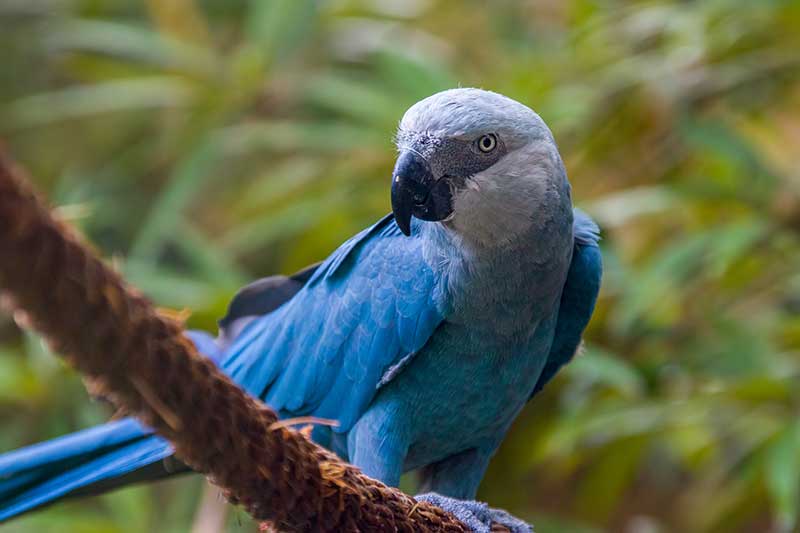
Also known as the little blue macaw, Spix’s macaw is a species that was once endemic to Brazil. By the time it was discovered in 1819, it was already rare due to a century of habitat destruction caused by burning, logging, and grazing in the Caatinga, a unique shrubland and thorn forest found only in northeast Brazil. The species experienced an even more rapid decline in the 1970s due to hunting, trapping, deforestation, and the construction of the Sobradinho Dam. In 2019, it was officially declared extinct in the wild.
A small captive population remains, but efforts to breed these birds have faced challenges. High levels of inbreeding have led to infertility and significant embryo mortality. However, recent advances in artificial insemination have provided hope for the species. A reintroduction programme has shown promise, with three Spix’s macaws successfully hatched in the wild in the state of Bahia, Brazil.
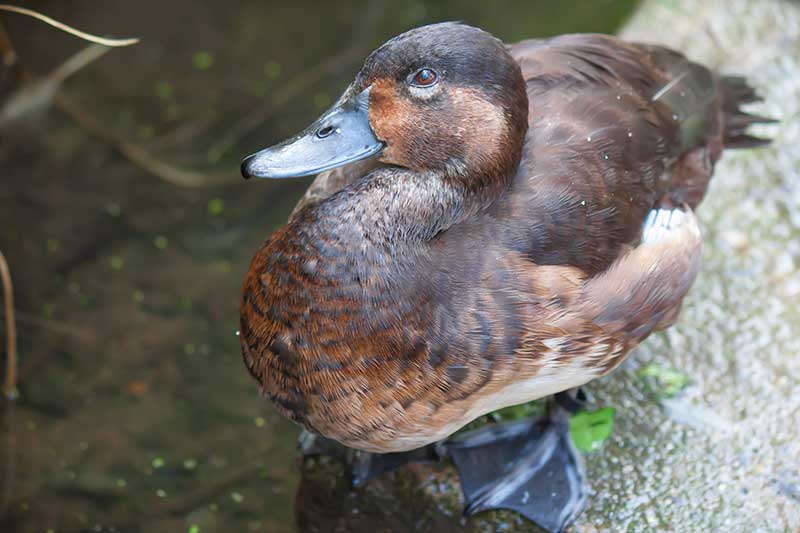
The Madagascar pochard is a critically endangered diving duck found exclusively in the inland wetlands of Madagascar, favouring shallow marshes and lakes with dense vegetation. Its population suffered a dramatic decline in the 1940s and 1950s due to deforestation, pollution, and the introduction of non-native fish species that preyed on pochard chicks and destroyed nesting habitats.
By the 1990s, the Madagascar pochard was believed to be extinct. However, in November 2006, a small population of nine adults and four ducklings was rediscovered on Lake Matsaborimena, or Red Lake, in a remote region of Madagascar. Unfortunately, the lake, being cold, deep, and lacking in aquatic vegetation, was unsuitable for long-term survival.
In response, the Wildfowl and Wetlands Trust, in collaboration with the Durrell Wildlife Conservation Trust, collected a clutch of eggs to incubate and raise in captivity. Their breeding efforts proved successful, and in 2018, 21 Madagascar pochards were released onto Lake Sofia, a freshwater lake in northern Madagascar better suited to their needs. In 2020, the reintroduced population successfully bred in the wild, offering a glimmer of hope for the species’ recovery.
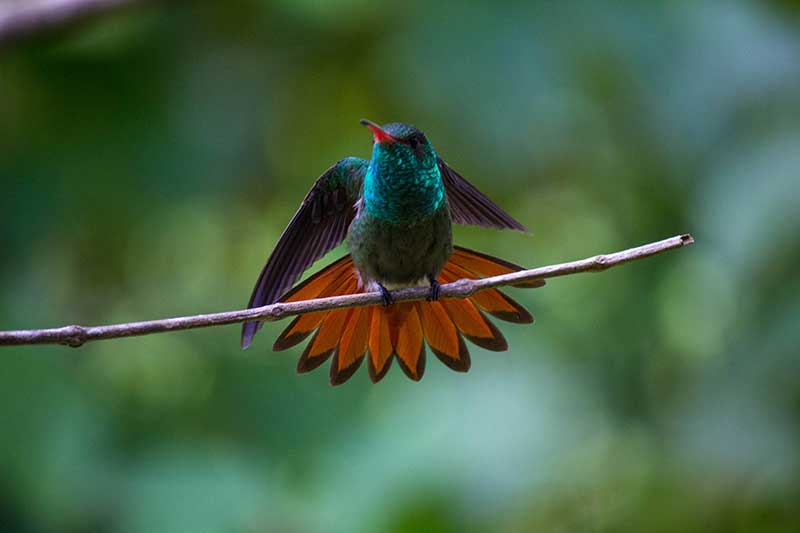
Classed as vulnerable, The Honduran emerald is a species of hummingbird endemic to Honduras, found in just three widely fragmented areas in the departments of Santa Bárbara, Cortés, Yoro, and Olancho, and with an estimated population of between 10,000 and 20,000 individuals.
Up to 90 percent of the Honduran emerald’s habitat has been lost to agriculture and human habitation or degraded due to cattle grazing, which has had a severe impact on the species’ population. In 2005, the American Bird Conservancy, supported the creation of the Honduran Emerald Reserve in the Aguan Valley, a 650 hectare site of tropical dry forest habitat. However, despite the IUCN dropping its assessment of the bird from Threatened due to increased knowledge about its distribution, numbers are thought to still be in decline.
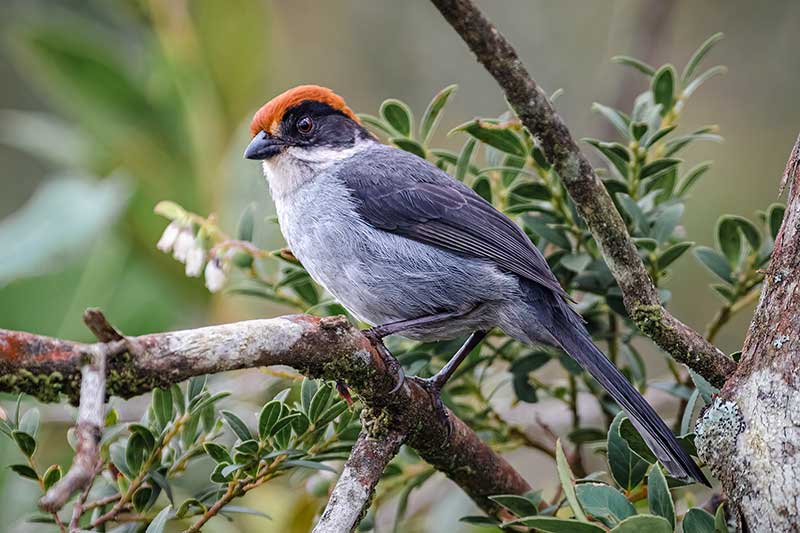
Very little is known about the Antioquia brushfinch. It was only scientifically described in 2007, when three specimens held in museums in Antioquia in Colombia, and previously thought to be slaty brushfinches, were re-examined and found to be separate species. Its scientific name refers to its pale underparts as well as to commemorate the Columbian lepidopterologist, Bianca Huertas, and wife of the ornithologist Thomas M. Donegan who described the species.
Until 2018, it was thought to be extinct when an eagle-eyed agronomist spotted an individual on his way to Sunday Mass in San Pedro de los Milagros. Since then fewer than 100 Antioquia brushfinches have been found with its scarcity thought to be due to habitat loss. Conservation efforts are underway to identify and protect areas of natural scrub that the species likes to call home.
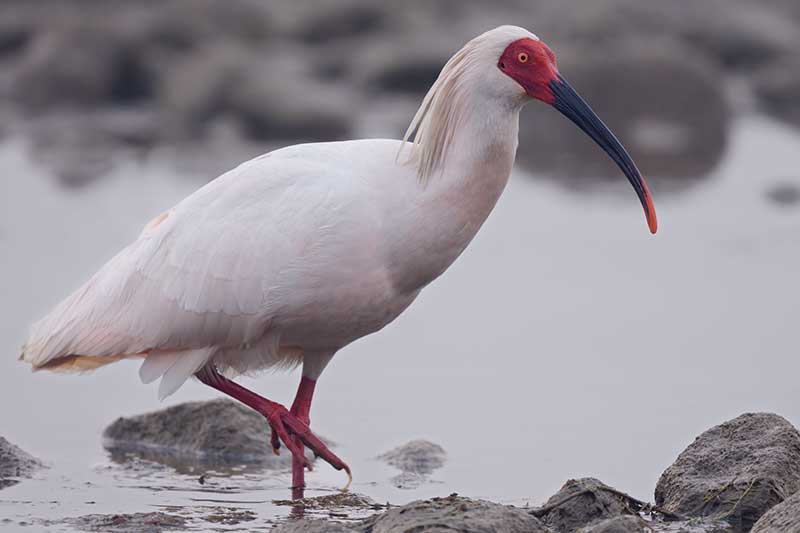
Also known as the toki, the crested ibis is a large white, exotic-looking waterbird with a patch of partially bare red skin on its head, that inhabits the pine forests of eastern Asia. The crested ibis has important roots in Japanese culture with the oldest record of the bird found in the Chronicles of Japan compiled in 720. It became extinct in Japan in 2003 and at one point was thought to be extinct in China too until its rediscovery in 1981.
Overhunting, pesticides, habitat loss, and winter starvation have all contributed to its demise. A successful conservation programme in Japan has seen hundreds of captive-born birds released into the wild with the first pair successfully breeding on Sado Island in 2012. In China, the crested ibis is on the country’s State Protection List with over 130 colonies remaining.
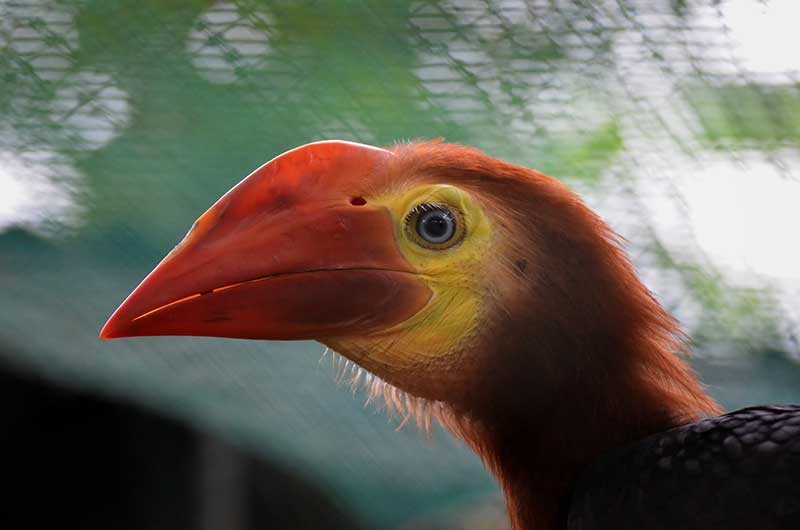
The rufous-headed hornbill is a critically endangered species of bird that lives in the rainforests on the islands of Negros and Paney in the Philippines. Also known as Walden’s hornbill and the Visayan wrinkled hornbill, and locally called dulungan, it has mostly black plumage and a large reddish-orange casque with wrinkles on its lower bill.
Rufous-headed hornbills nest in cavities in trees using saliva and mud to seal the hole with the female and chicks inside. They reproduce very slowly, breeding only once every few years and due to severe deforestation for logging and lack of nesting sites, numbers have dwindled to a total population of about 150. A conversation programme is underway with nest boxes erected in suitable habitats to encourage breeding.
The other major threats to the species are hunting and capture for the illegal wildlife trade. Philincon, an initiative for environmental conservation, pays local residents to guard the hornbills’ nests and offers a bounty for successful fledges which has seen poaching rates dramatically reduced.
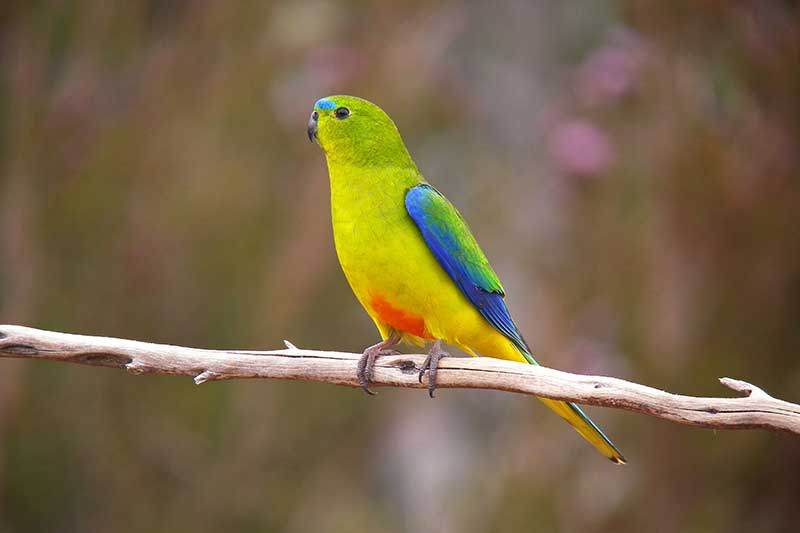
The orange-bellied parrot is endemic to southern Australia and one of just a few species of parrot to migrate. It breeds in South West Tasmania in eucalyptus trees on the edge of buttongrass moors and usually no further than 30 km from the coast. In the winter it migrates to the coast of South-East Australia inhabiting salt marsh estuaries and lagoons. Sometimes making a stop-off at King Island in the Bass Strait.
Orange-bellied parrots exhibit sexual dimorphism; the male has a bright grassy-green head and upperparts, yellow underparts, and an orange patch on its belly. The wings are blue and there is a thin blue line between its eyes. The female is duller green overall. It feeds in flocks or pairs, foraging low on the ground for glasswort, seeds, and berries.
It used to be much more widespread found along the mainland coast from Sydney to Adelaide during breeding season, but its range has shrunk due to habitat loss, disease, and lack of genetic diversity. In 2016 it was estimated that there were just 16 individuals left in the wild. A captive breeding programme has seen numbers recover somewhat, although in 2018 it was ranked as the second most likely bird to go extinct in Australia after the King Island brown thornbill,
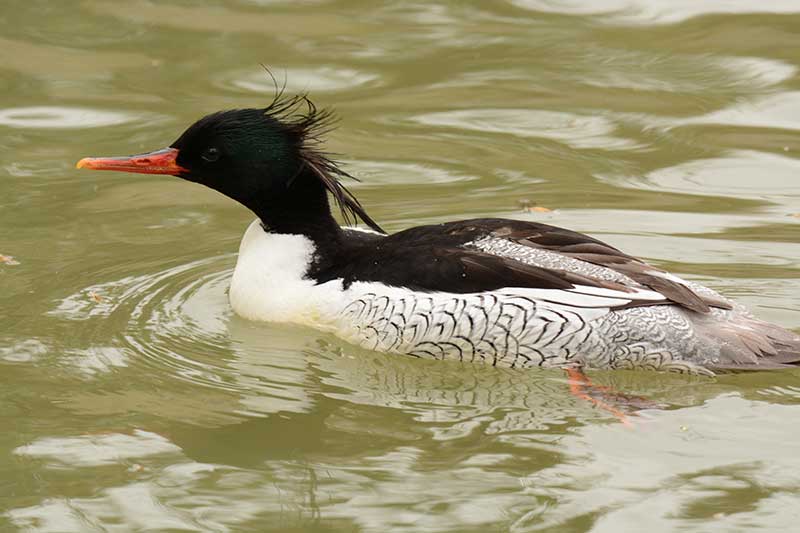
The scaly-sided merganser, also known as the Chinese merganser, is an endangered sea duck that breeds in old-growth forests in limited areas of the Russian Far East and China. The male has a glossy green head and a black-and-white back, while the female has a rusty brown head and a grey back. Both sexes are characterised by distinctive dark-edged white scales on their sides, which set them apart from other mergansers.
The species nests in tree cavities along montane rivers but will also use artificial nest boxes provided as part of conservation efforts. It shares its habitat with the Mandarin duck, competing for nesting holes that neither species can excavate. During the winter, it also competes with other members of the Merginae subfamily, such as the common merganser and the goldeneye.
The population of the scaly-sided merganser declined significantly in the 1960s and 70s due to the loss of primary forests within its range. Fewer than 5,000 individuals are now thought to remain. Other threats include illegal hunting, entanglement in fishing nets, and water pollution.
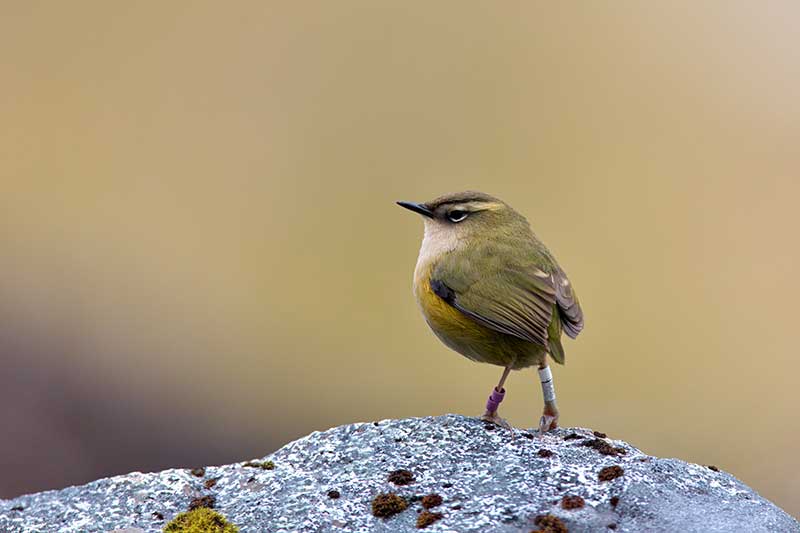
The New Zealand rock wren is one of only two remaining wren species in New Zealand. Known by several Māori names, including pīwauwau (“little complaining bird”) and tuke (“twitch”, referring to its bobbing motion), this tiny alpine bird has almost no tail, long legs, and short, rounded wings. It has greenish-yellow upperparts, paler underparts, and yellow flanks, with pale tips on the secondary wing feathers creating a row of spots visible when perched. Females are similar but generally duller, though this varies geographically.
The rock wren is found in alpine and sub-alpine regions of the South Island, though its distribution is patchy. It inhabits areas near the treeline, including rockfalls, scree, fellfields, and low scrub. Unlike many other alpine birds, rock wrens do not migrate to lower elevations in winter but remain in their habitat, foraging beneath the snow layer.
In the 1930s. the New Zealand conservationist Herbert Guthrie-Smith wrote:
Xenicus gilviventris, I am glad to think, is one of the species likely to survive changes that from the forester’s and field naturalist’s point of view have desolated New Zealand. The ravages wrought elsewhere by deer, rabbits, opossums, birds, and other imported vermin are unlikely to affect the welfare of the rock wren.
Unfortunately, his prediction proved incorrect, and since European settlement, rock wren numbers have declined drastically. Invasive species like stoats and mice have taken a heavy toll by preying on their eggs and chicks. Conservation efforts, including relocating rock wrens to rodent-free islands, have shown some success in protecting the species. In 2022, the rock wren was honoured as New Zealand’s Bird of the Year.
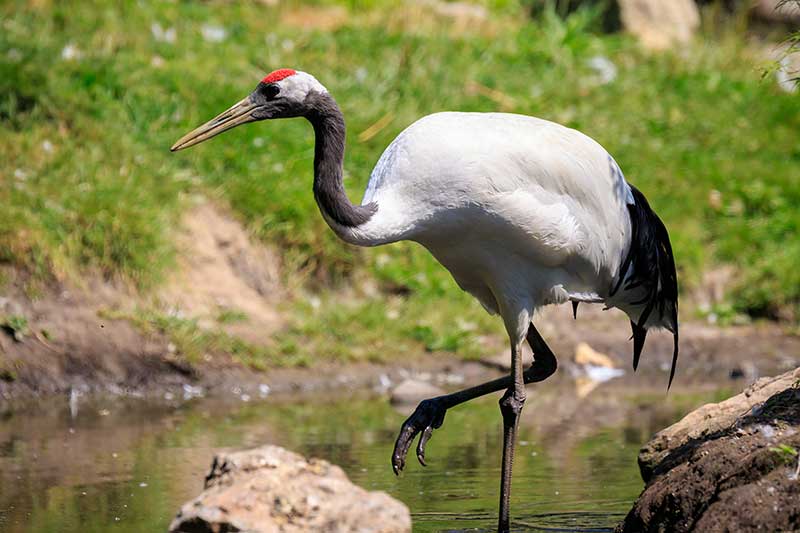
The red-crowned crane is an iconic bird, often depicted in traditional Chinese and Japanese art, including paintings and ceramics. The male has a white body with long black secondary wing feathers, which can appear tail-like when the bird is standing, alongside white tail feathers. Its head has black markings on the neck, throat, and cheeks, with a distinctive scarlet patch on the crown that gives the species its name. The bill is olive green, the eyes are dark brown, and the legs and feet are slate grey. The female is similar in appearance but has greyer tones in the black areas of the head.
Red-crowned cranes breed in the marshy meadows and wetlands of Siberia and northeast China, primarily around Lake Khanka. They migrate during winter to the Korean Peninsula and east-central China, where they inhabit paddy fields, mudflats, marshes, and other open areas. There is also a resident population in eastern Hokkaidō, Japan.
As one of the rarest crane species in the world, the red-crowned crane faces significant challenges. While populations in Japan and those wintering in Korea have seen recent growth, the number wintering in China has declined rapidly due to habitat loss, poisoning, and poaching. In Japan, suitable nesting habitats are scarce, and the local breeding population is nearing saturation.
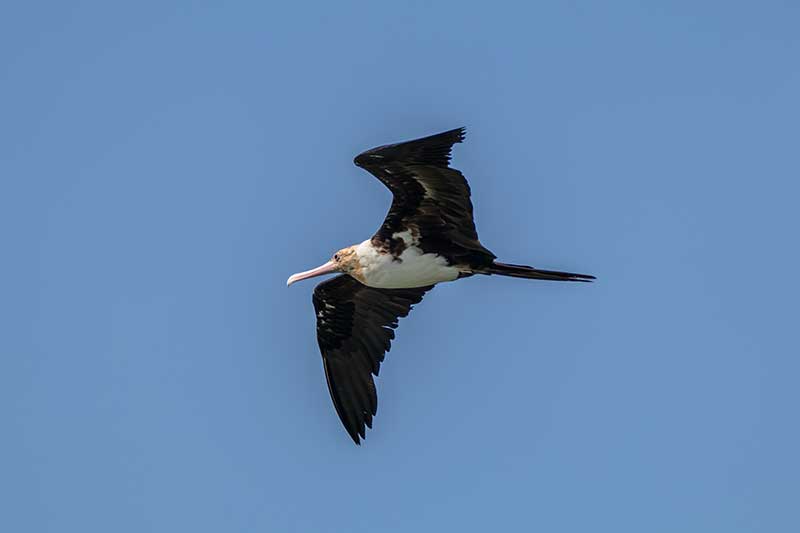
The Christmas frigatebird, also known as the Christmas Island frigatebird, is a large, black seabird endemic to Christmas Island in the Indian Ocean. Adult males have a white, egg-shaped patch on their belly, a vivid red gular sac, and white spurs that extend outward from their body onto their wings. Females, slightly larger than males, have a white collar and a belly patch that extends onto the breast.
The Christmas frigatebird has a very limited breeding area and nests in just four colonies, with most breeding occurring within the Christmas Island National Park. However, around 10% of the population nests outside the park, leaving them without formal protection.
This species has faced significant challenges due to the accidental introduction of yellow crazy ants to Christmas Island in the mid-20th century. These invasive ants have decimated the island’s land crab population, leading to an overgrowth of seedlings that were once controlled by the crabs. The resulting changes in forest structure have severely impacted the Christmas frigatebird’s nesting habitats.
It is estimated that fewer than 5,000 individuals remain. Alongside habitat loss, the species is also threatened by entanglement in fishing gear and the ongoing effects of phosphate mining on the island.
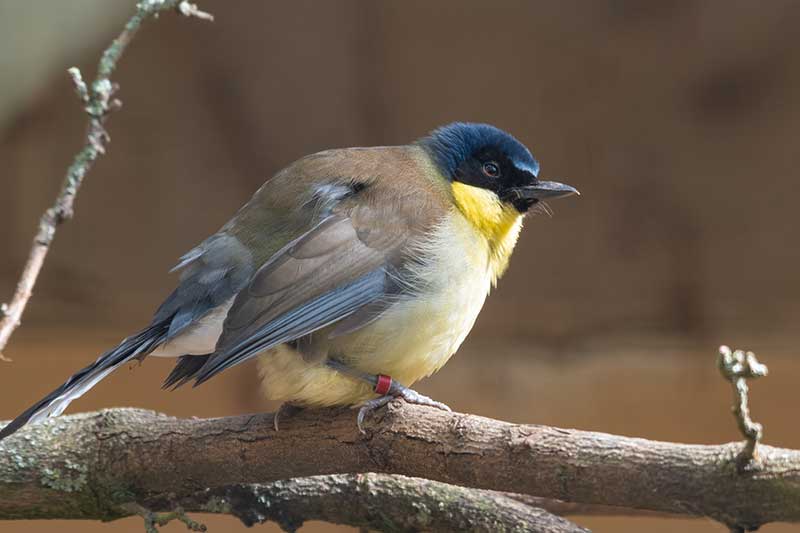
The blue-crowned laughingthrush, also known as Courtois’s laughingbird, is a small songbird found exclusively in Wuyuan County in Jiangxi Province, China. It has brown upperparts, bright yellow underparts, a black “bandit’s mask” across its face, and a blue crown with a silver-lined forehead.
This bird was believed to be extinct until 1988, when it unexpectedly appeared in the international pet bird trade. Prior to this, it was known only from museum specimens. Two specimens had been collected in Wuyuan County, and three more in Simao, Yunnan Province, in 1956. These specimens were initially thought to be a subspecies of the yellow-throated laughingthrush.
Today, it is estimated that around 300 individuals remain in the wild. Conservation efforts have established populations in zoos, including Marwell Zoo, Exmoor Zoo, and Newquay Zoo in the UK, as part of a captive breeding programme.
In 2006, the blue-crowned laughingthrush was mistakenly listed as a species of Least Concern on the IUCN Red List. This error was corrected in 2007, with the species being reclassified as Critically Endangered due to its small population and limited range.
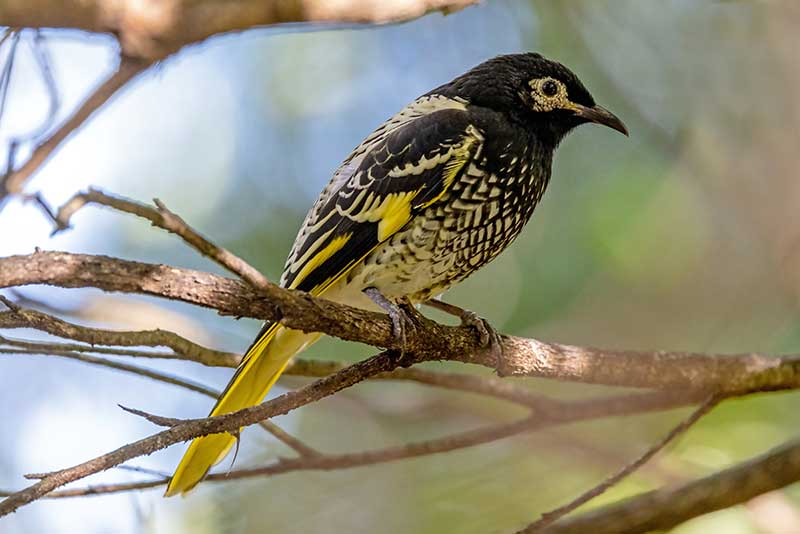
The regent honeyeater is a critically endangered bird native to the dry forests of southeastern Australia. It has black, white, and lemon-yellow plumage with a scaly pattern and a black tail edged with broad yellow bands. Its head and throat are black, with a large, warty yellow patch of bare skin around the eyes. The female’s eye patch is only under the eye, and she has less black on her throat.
Once common in eastern Australia, the population has declined by 80% in the past 25 years, leaving an estimated 250 individuals in the wild. This decline is due to drought, habitat loss from forest clearing for agriculture, and possible competition with other native species. Many breeding sites were also affected by the bushfires of 2019 and 2020.
A 2021 study revealed that the rapid decline in the population has made it harder for young males to learn mating calls, with some imitating the songs of other bird species instead, which may reduce their chances of finding mates.
Recent conservation efforts, including captive breeding programmes, have shown tentative success, with the first birds being released back into the wild.
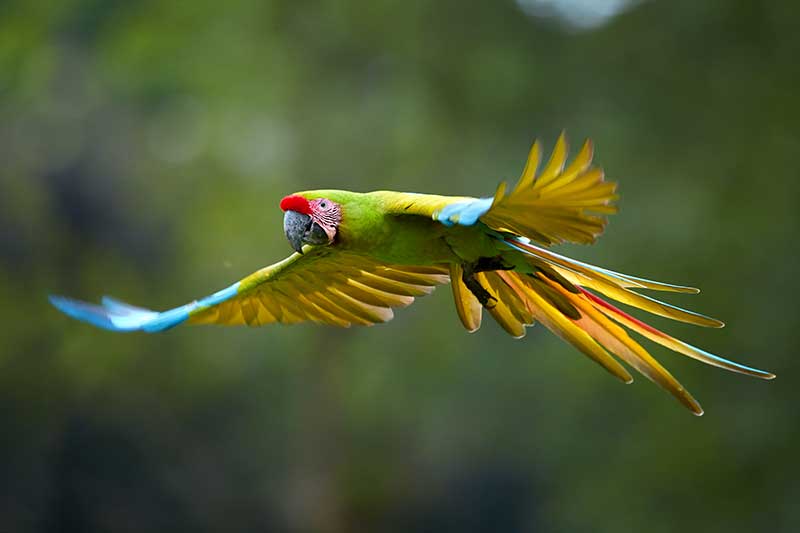
The great green macaw, also known as Buffon’s macaw or the great military macaw, is a large parrot native to the tropical forests of Central and South America. It is the largest parrot in its range, the second-heaviest macaw, and the third-heaviest parrot overall.
It has lime green plumage, with blue flight feathers, a blue lower back and rump, and a reddish-brown tail tipped with pale blue. Its face has bare reddish skin marked by dark feather lines, and a prominent red patch on its forehead above the bill. Where their ranges overlap, it can easily be mistaken for the similar-looking military macaw.
The great green macaw is listed as critically endangered by the IUCN and faces the risk of extinction in Costa Rica. The total wild population is estimated to be between 500 and 1,000 individuals.
The primary threat to its survival is habitat loss, as tropical forests are cleared for agricultural use, particularly for oil palm, pineapple, and banana plantations. The species has also been targeted by the pet trade. While it is protected under CITES Appendix I, which bans international trade, illegal poaching still occurs, with chicks being sold for hundreds of dollars.
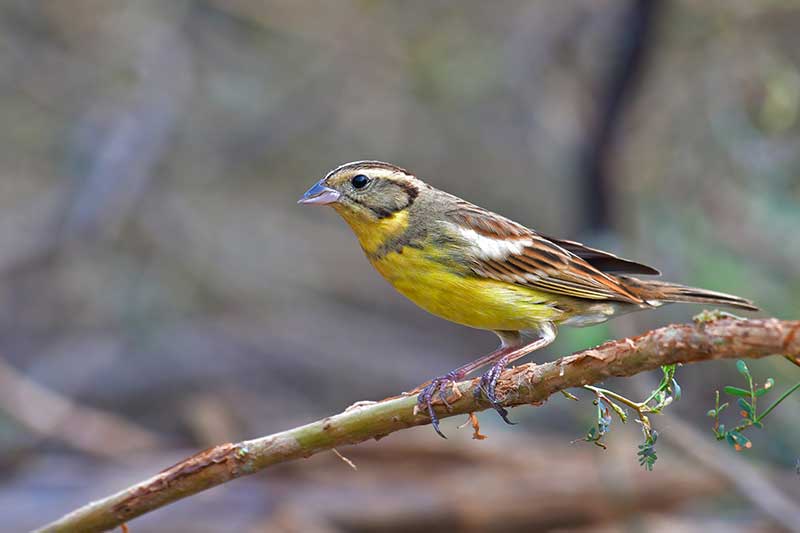
The yellow-breasted bunting, often referred to as the rice bird in China, is a songbird that winters in paddy fields. During the breeding season, the male has chestnut upperparts with white wing bars, and bright yellow underparts with a chestnut breast band. Its head has a black face and a chestnut crown. Outside of the breeding season, the male’s plumage becomes much duller. The female has streaked grey-brown upperparts, dull yellow underparts, and a white face with dark stripes on the crown, eye, and cheeks.
Once considered one of the most abundant passerines in Eurasia, the global population of the yellow-breasted bunting was estimated to number several million, with its breeding range expanding westward into Europe until the 1980s. As recently as 2004, it was classified as a species of Least Concern.
However, the bird has now almost vanished from Europe and the northern parts of Siberia and Japan. Today, most of the population migrates from Siberia to wintering grounds in China and Southeast Asia. In 2017, the species was listed as Critically Endangered on the IUCN Red List.
The yellow-breasted bunting’s dramatic decline is largely attributed to illegal hunting. The birds are trapped in mist nets at migration and wintering sites and sold on the black market, where they are considered a delicacy. Habitat loss has also played a significant role. As the market value of rice dropped, many farmers switched to growing vegetables, rendering the bird’s traditional wintering grounds unsuitable.
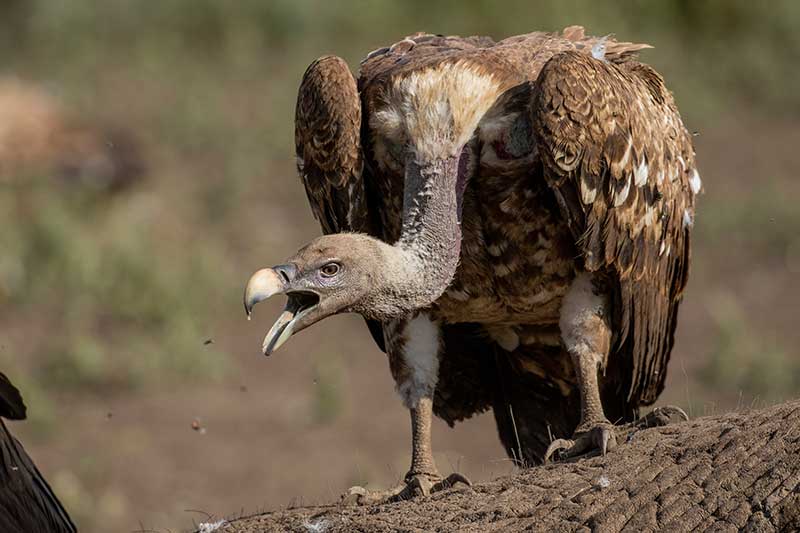
The white-backed vulture is an Old World vulture found across sub-Saharan Africa in woodlands, savannas, steppes, open swamps, riverine forests, and thornbush areas. It has buffy-brown plumage with pale patches under its wings, a white back and rump, an almost bare head with a few downy feathers, and a white ruff around its neck.
In 1992, the global population was estimated at 270,000 individuals, and although the white-backed vulture still remains the most common vulture in Africa the population has since declined by about 80%.
The decline is due to intentional and accidental poisoning from feeding on poisoned carcasses or carcasses treated with Diclofenac, an anti-inflammatory drug used to treat livestock that causes liver and kidney toxicity in the vultures. Habitat loss from agricultural expansion and fires, declines in wild ungulate populations, hunting for trade, and collisions with powerlines have also contributed to its decline. In 2007, it was listed as Near Threatened on the IUCN Red List , but in 2015, it was uplisted to Critically Endangered.
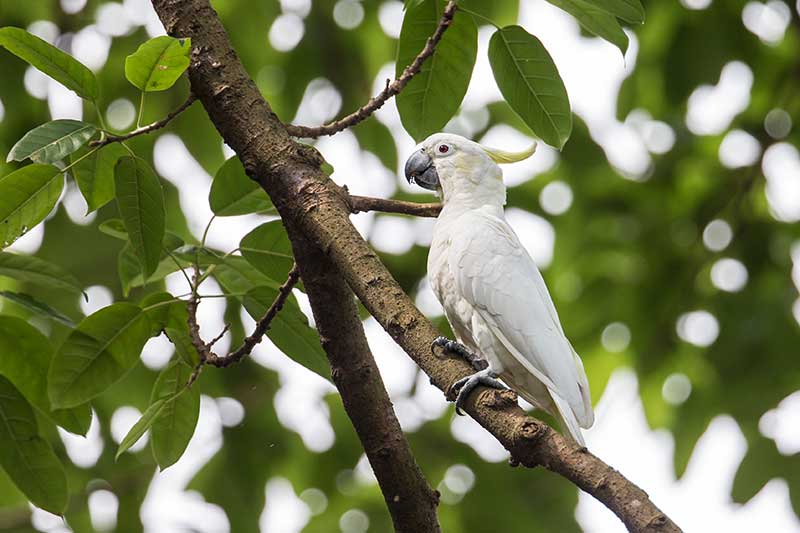
The yellow-crested cockatoo, also known as the lesser sulphur-crested cockatoo, is a critically endangered bird native to the forests of Indonesia and East Timor. It has white plumage with pale yellow patches on its cheeks, blue-grey bare skin around the eyes, a black bill, and a bright yellow or orange crest. It is often confused with the more common sulphur-crested cockatoo, but which can be distinguished by the lack of yellow on the cheeks. There are five recognised subspecies.
The population has declined dramatically, primarily due to illegal trapping for the cage-bird trade. Between 1980 and 1992, over 100,000 were legally exported from Indonesia. Although commercial capture has been banned since 1994, illegal hunting continues. Habitat loss caused by logging has also contributed to their decline.
A small, introduced population of around 200 individuals, descended from escaped pets, exists in Hong Kong, which represents roughly 10% of the total wild population. A widely circulated story claims that Hong Kong Governor Sir Mark Aitchison Young released the entire caged-bird collection, including a large number of yellow-crested cockatoos, from Government House just before surrendering Hong Kong to Japanese forces in December 1941. However, there is no evidence to support this account.
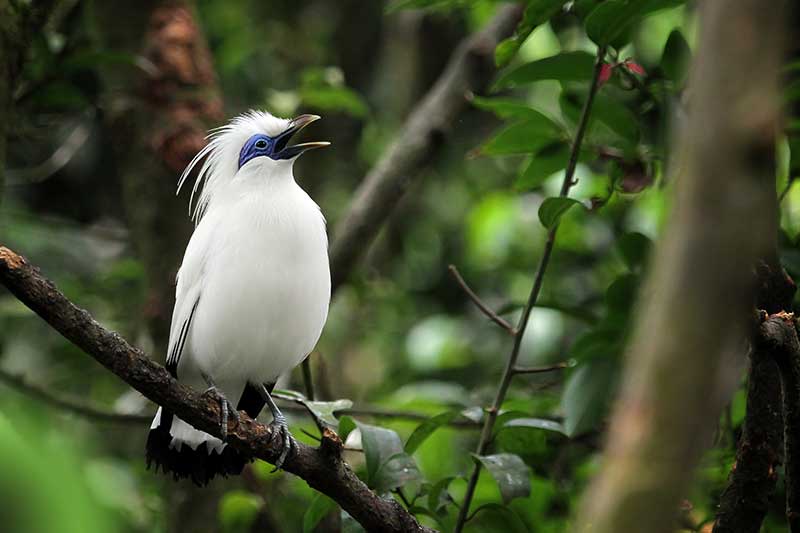
The Bali myna, also known as Rothschild’s myna, is a medium-sized starling and the only bird species endemic to Bali. It has an extremely limited range, confined to the open forests of northwest Bali. Unlike most starlings, it spends most of its time in trees, only descending to the ground to drink or collect nesting materials.
It has white plumage with black tips on its wings and tail. Its head is adorned with long plumes that droop down the back of its nape. It has blue bare skin around its eyes, a yellow bill, and blue legs and feet. Males and females look similar, though males have a longer crest.
Critically endangered, the Bali myna is thought to number fewer than 50 individuals in the wild and has been on the brink of extinction since the 1990s. The drastic population decline is primarily due to illegal poaching for the caged bird trade and habitat destruction caused by human activity, including tourism and agriculture.
Conservation efforts have focused on collaboration with aviculture breeders. Licensed breeders are permitted to rear the birds under the condition that they release 10% of their stock into West Bali National Park, where the birds can be monitored by park authorities. The remaining birds can be kept for private sale, providing an incentive for breeders to support the species’ survival.
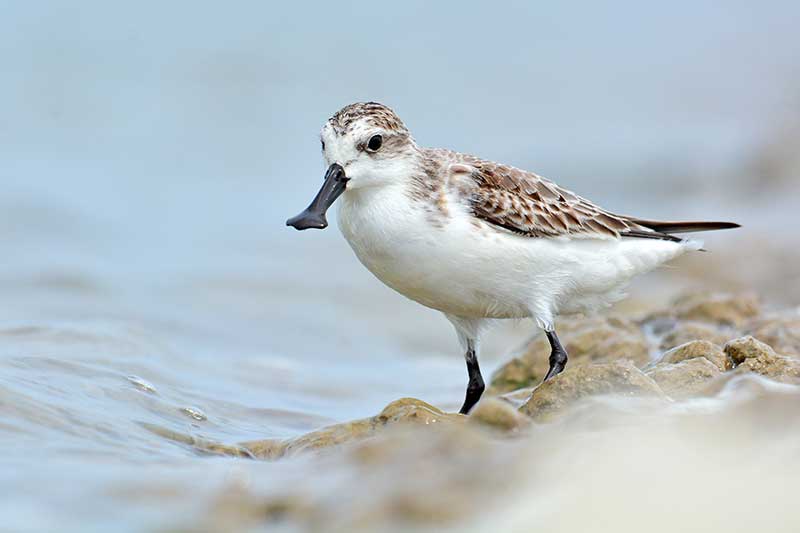
The spoon-billed sandpiper is a critically endangered small wader, recognised by its distinctive spatulate bill. It breeds on the coastal mudflats of the Bering Sea and migrates during winter to Southeast Asia, including regions in India, Bangladesh, Myanmar, Vietnam, and Singapore.
In breeding plumage, it has dark upperparts with buff and rusty-red edges to the feathers, creating a mottled appearance. Its underparts are white, with black streaks on the upper breast. The head is rusty red, extending to the breast, with dark streaks on the crown. Outside of the breeding season, it is paler overall, with white fringing on the upperparts that extends to the crown. The face becomes white, with a dark ear patch.
The global breeding population is estimated at just 250 to 500 individuals. It faces numerous threats, including habitat loss across its breeding, migratory, and wintering grounds, exacerbated by human disturbance, pollution, and the ongoing effects of climate change.
In 2011, a group of 13 spoon-billed sandpipers was brought to the WWT reserve in Slimbridge, Gloucestershire, as part of a conservation effort in partnership with Birds Russia. The initiative focused on a technique known as “headstarting,” which involves collecting eggs, hatching them in a controlled environment, and hand-rearing the chicks for release once they have fledged. Since then, 205 spoon-billed sandpiper chicks have been successfully released into the wild in Arctic Russia using this method. Notably, some of the first headstarted birds have gone on to produce their own chicks, and even a few headstarted “grand-chicks” have been recorded, a hopeful sign for the species’ recovery.
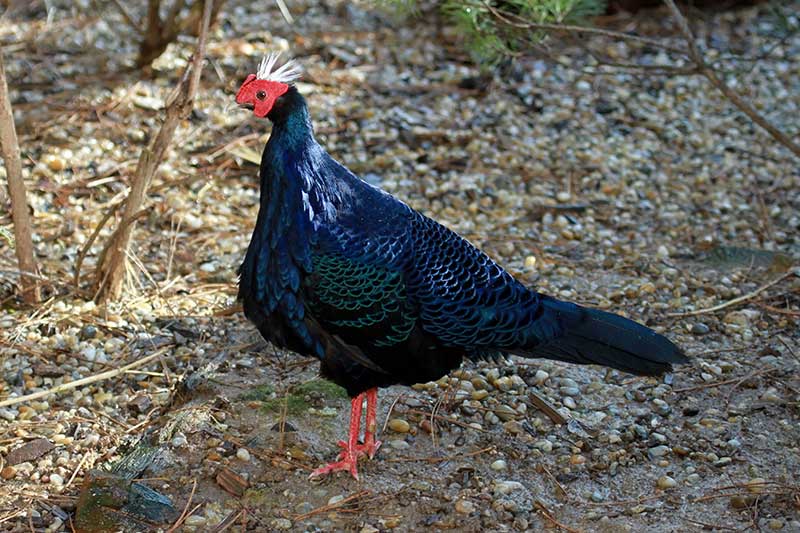
Edward’s pheasant is a critically endangered species endemic to the tropical evergreen forests of central Vietnam. It inhabits hilly terrain with abundant palms and patches of bamboo in remote areas.
The male has dark, iridescent blue plumage with lighter feather edges that create a lacy pattern. It has metallic green fringes on its upper wings, while its tail is blue-black, straight, and rigid, with shorter outer feathers. It has bright red wattles and a facial patch, a short white crest, and an ivory bill with a horn-coloured base. The legs and feet are red, each with a single spur.
The female is smaller and chestnut-brown, with a greyish tint on her underparts and reddish-brown upperparts. She has blue-black tail feathers, a grey head, and lacks the crest seen in males.
A subspecies, (L. e. hatinhensis), commonly known as the Vietnamese pheasant, is similar but distinguished by a variable number of white tail feathers.
Edward’s pheasant is among the most endangered Galliformes, with an estimated population of just 50–250 individuals in zoos and private collections. None have been seen in the wild since 2000, and any remaining wild populations are thought to be extremely small and in decline.
The species’ loss is attributed to habitat clearance for logging and agricultural expansion, hunting and trapping, and herbicide spraying during the Vietnam War.
7 Responses
hoopoes are also rare
This was good to know, thank you! The blue crowned laughingthrush is my favourite.
How rare is a white peacock?
I believe I am seeing the Eurasian tree-sparrow in Green Valley, AZ. Your site speaks of them in St. Louis, MO and in Illinois. Are they everywhere? Thank you.
no ghost bird?
its so ugly omg
How rare is a White Owl